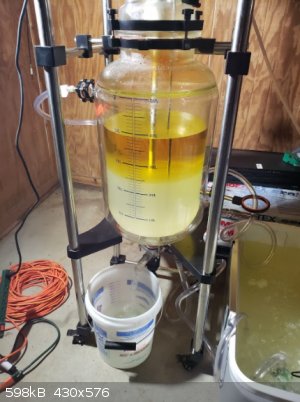
Fyndium - 28-2-2021 at 11:03
How labs do bigger batches of separation and extraction? Bigger than 5L separatory funnels begin to get too heavy to handle, so I suppose they use
stationary, stirred separatory funnels like in brewing?
Years ago, I did an improvised separatory funnel from transparent bucket and a valve. It did work great, and cost about 5€ with all the parts.
itsallgoodjames - 28-2-2021 at 17:59
If you're trying to separate large amounts of liquids, decant as much of the liquid as possible then use a sep funnel on the rest of it
Fyndium - 28-2-2021 at 18:28
During benzaldehyde synthesis I used glass tube and tubing to suction out the BzH settled to the bottom. So yeah, there are other methods too.
zed - 28-2-2021 at 18:49
Use vacuum to siphon.
draculic acid69 - 1-3-2021 at 04:12
I think once U go past the 5L point U go with buckets/tubs/the/drums with taps on them or go with the vacuum siphon method
Praxichys - 1-3-2021 at 08:14
Here is a 50L example. Coarse extraction is achieved using a bottom tap (in progress, see image). Once the boundary gets close to the drain, the flow
is slowed to prevent a vortex which would cause waste.
When the level is as close to the layer as one can best manage, the valve is closed. Rapid stirring commences to dislodge adhering liquid from the
reactor walls, followed by more settling time to let it fall to the bottom.
The bucket is meanwhile swapped for a pitcher-like transfer container eventually used to fill a 2L sep funnel. The tap is pulsed open and shut a few
times until the amount drawn reaches about 3/4 the volume of the sep funnel. This purges remnants of the heavy layer from the reactor and purges the
valve body with product. The sep funnel is used as normal for fine separation and any product is returned to the reactor for the next step.

Siphoning with a long glass tube is also an option. This method would be preferable if the next step could not tolerate any waste from the previous
step, as there are invariably adhering droplets. In my case they are taken care of during the drying step and are of little consequence.
njl - 1-3-2021 at 08:27
What solvents are you using here?
Praxichys - 1-3-2021 at 11:33
Just water. The bottom layer is mostly aqueous sodium sulfate with some sulfuric acid; the top is product. This is just a big acid-catalyzed
esterification.
